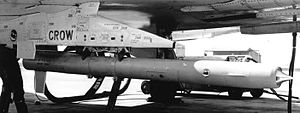- Crow (missile)
-
Crow 
Guided version of Crow on F-4B PhantomType Experimental missile Place of origin  United States
United StatesService history In service 1961-1965 Used by United States Navy Production history Manufacturer Naval Air Missile Test Center Number built 7 Specifications (Unguided version) Weight 300 pounds (140 kg) Length 9 feet 7 inches (2.91 m) Diameter 8 inches (200 mm) Engine Rocket-ramjet; rocket, 10,000 lbf (44.5 kN)
ramjet, 220 lbf (0.98 kN)Wingspan 28 inches (710 mm) Propellant Solid fuel Operational
range97 nautical miles (180 km; 112 mi) Speed Mach 3 Guidance
systemNone Launch
platformF4D Skyray
F-4 Phantom IIThe Creative Research On Weapons or Crow program was an experimental missile project developed by the United States Navy's Naval Air Missile Test Center during the late 1950s. Intended to evalulate the solid-fueled integral rocket/ramjet (SFIRR) method of propulsion as well as solid-fueled ramjet engines, flight tests were conducted during the early 1960s with mixed success.
Contents
Development and RARE
Studies of the rocket-ramjet and solid-fueled ramjet concepts begain at the U.S. Navy's Naval Air Missile Test Center - later the Naval Missile Center - at Point Mugu, California in 1956, with the intent of increasing the range of small air-to-air missiles through using the combined ramjet and rocket propulsion system with solid fuels only.[1] Following extensive ground testing, the concept was considered promising enough for a flight-test vehicle to be constructed to fully evalulate the new engine.[2]
The first flight test vehicle, known as Ram Air Rocket Engine or RARE, was developed by the Naval Ordnance Test Station at China Lake, California. RARE was constructed using a conventional five-inch (127mm) rocket tube, 10 feet (3.0 m) in length and weighing 153 pounds (69 kg).[3] Rocket-sled tests conducted during 1956 indicated that the rocket-ramjet configuration would be stable;[1] three flight tests were conducted between 1959 and 1960, with the RARE rocket reaching speeds of Mach 2.3.[4]
Crow I
Even as testing of RARE was undertaken, the Naval Air Missile Test Center was developing their own test vehicle. Known as CROW, or Creative Research on Weapons, the NAMTC vehicle was intended to demonstrate that a solid-fueled rocket-ramjet was capable of delivering a reasonable payload.[4] A simple unguided rocket, the first Crow vehicle, known as Crow I,[2] was intended for aerial launch at low supersonic speed and an altitude of 50,000 feet (15,000 m).[4] After launch, the booster acted as an ordinary solid-fueled rocket; however upon burnout of the booster stage, the rocket's casing acted as the duct for a ramjet engine, with remaining solid fuel being mixed with the incoming air to provide thrust.[2]
The first flight test, from a Douglas F4D Skyray launch aircraft, was undertaken on January 19, 1961; due to a flaw in the launch mechanism, the rocket failed to ignite, and the test was a failure. Modifications were made, and that November two successful flights of the Crow I vehicle were conducted.[2]
Controlled Crow
With the ballistic Crow I having proved the propulsion concept sound, follow-up work on a modification of the vehicle to provide guidance was undertaken.[2] The missile was fitted with a simple autopilot, utilising infrared horizon-scanning to maintain the missile's attitude in flight.[2]
Captive flight tests of Crow began in February 1963 aboard a F-4B Phantom II carrier aircraft; on May 29, the first test launch was attempted, with three further launches taking place through May 1965. None of first three attempted flights were successful, however; malfunctions in the rocket motor, autopilot, and controls plagued the program.[2] The fourth flight test proved more successful, and Crow was considered to have met the project goals.[4]
The Crow project successfully established the solid-fueled rocket-ramjet as a viable method of propulsion;[2] consideration of Crow for use as an air-to-air missile or target drone was undertaken, but this was not pursued.[4]
See also
References
- Notes
- Bibliography
- "Chapter 6: Propellants and Propulsion for Missiles" (PDF). Technical Program Review 1956. China Lake, CA: U.S. Naval Ordnance Test Station. January 1 1957. http://www.dtic.mil/cgi-bin/GetTRDoc?Location=U2&doc=GetTRDoc.pdf&AD=AD0128000. Retrieved 2010-01-14.
- Parsch, Andreas (2004). "Naval Missile Center Crow". Directory of U.S. Military Rockets and Missiles. designation-systems.net. http://www.designation-systems.net/dusrm/app4/crow.html. Retrieved 2011-01-14.
- Parsch, Andreas (2007). "(Other): "Missile Scrapbook"". Directory of U.S. Military Rockets and Missiles. designation-systems.net. http://www.designation-systems.net/dusrm/app4/other.html. Retrieved 2011-01-14.
- Waltrup, Paul J.; Michael E. White, Frederick Zarlino, Edward S. Gravlin (April-June 1997). "History of Ramjet and Scramjet Propulsion Development for U.S. Navy Missiles" (PDF). Johns Hopkins APL Technical Digest (Laurel, MD: The Johns Hopkins University Applied Physics Laboratory) 18 (2). ISSN 0270-5214. http://www.jhuapl.edu/techdigest/TD/td1802/waltrup.pdf. Retrieved 2011-01-14.
USN drone and missile designations 1947–1962 Air-launched missiles Air-to-air missilesAir-to-surface missilesAir-to-underwater missilesAUM-N-2 • AUM-N-4 • AUM-N-6
Surface-launched missiles Surface-to-air missilesSurface-to-surface missilesSSM-N-2 • SSM-N-4 • SSM-N-6 • SSM-N-8 • SSM-N-9 (I) • SSM-N-9 (II)
Surface-to-underwater missilesSUM-N-2Test vehicles ControlLaunchingLTV-N-2 • LTV-N-4
PropulsionPTV-N-2 • PTV-N-4
Research and general testingSee also: BOAR • CROW • Diamondback • Gimlet • Hopi • Ram • RARE • Tiny Tim Types of missile By platform Air-to-air missile (AAM) · Air-to-surface missile (ASM) · Surface-to-air missile (SAM) · Surface-to-surface missile (SSM) · Ballistic missile · Intercontinental ballistic missile (ICBM) · Submarine-launched ballistic missile (SLBM) · Anti-ballistic missile (ABM) · Intermediate-range ballistic missile (IRBM) · Cruise missile · Anti-ship missile (AShM) · Anti-submarine missile · Anti-tank missile (ATGM) · Anti-satellite weapon (ASAT) · Air-launched ballistic missile · Anti-ship ballistic missile (ASBM)By guidance Anti-radiation · Wire guidance · Infrared guidance · Beam riding · Laser guidance · Active radar guidance · Semi-active radar guidance · Unguided rocketsLists Categories:- Cold War missiles of the United States
- Experimental missiles
- Ramjet engines
- Solid-fuel rockets
Wikimedia Foundation. 2010.


